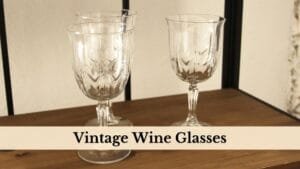Would you believe me if I said that those old wine glasses that you’ve decided to throw could be worth a thousand or more? That’s right! Vintage wine glasses are hot collectibles these days, with rare finds selling for $2,000 or even more!
So, if you have a set of antique wine glasses, this guide is just for you! It explains key signs to spot authentic antique glasses and what makes them worth big money, along with some rare examples that you NEED to find right away!
How to Identify Vintage Wine Glasses
Let me break this down into the key areas that’ll help you separate the really valuable glasses from the rest!
Physical Characteristics
Vintage wine glasses always show some unique physical features that modern glasses don’t, such as:
- Weight: Pick up that glass and feel the weight! Vintage wine glasses feel completely different from modern ones. They’re heavier. That’s because old glass contains lead, which makes it denser and gives it that substantial feel in your hand. You can also compare it to modern glassware, like I do.
- The Bowl Size: The size of the bowl can also help you date your glass. Victorian wine glasses (1837-1901) have larger bowls than their Georgian predecessors (1714-1830). Why? Wine got cheaper in the 1800s. Plus, larger bowls gave glass artists more space to show off their engraving skills.
- The Foot: Look at the base of the glass. Does the edge fold under like a hem on clothing? This “folded foot” was used before 1760 to prevent chipping. Finding one is like discovering a time stamp—it tells you you’re holding something truly old.
Collector’s Tip: Do a ring test by gently tapping the rim with your fingernail. Real lead crystal produces a clear, bell-like chime that sustains for several seconds. Regular glass makes a dull thunk.
Marks & Manufacturing Clues
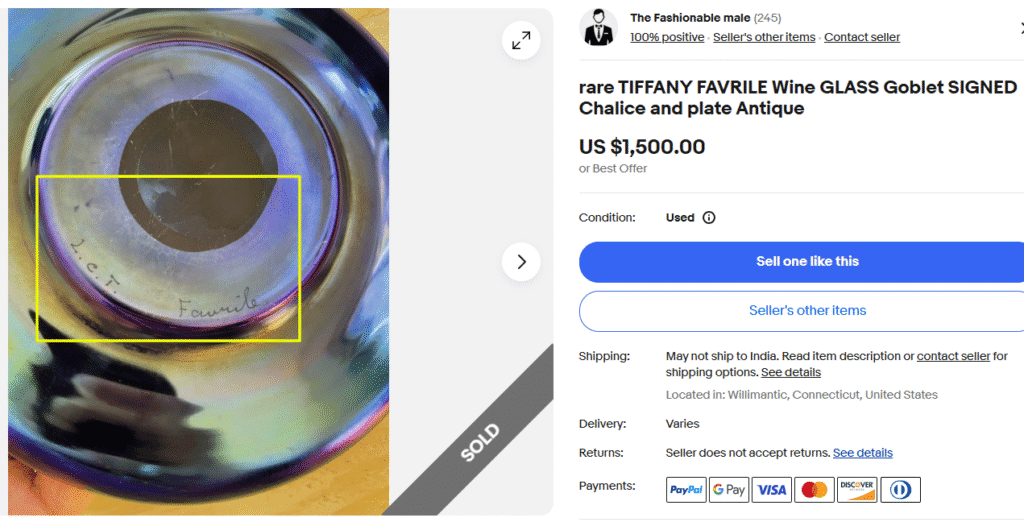
To authenticate an antique wine glass, you need to check for certain marks.
Maker’s Marks
Manufacturer marks are pretty rare on true antiques (anything before 1900). When you do find marks, they’re usually super subtle – maybe an etched signature on the base from a fancy glasshouse.
Marks became more common once mass production kicked in during the 20th century. You might see acid-etched marks, molded symbols, or the remnants of paper labels (though those rarely survive).
If there’s a clear, obvious molded mark, you’re probably looking at mid-20th-century stuff rather than a genuine antique.
Also, apart from the company marks, logos, or numbers, you may also see artists or designers’ signatures, too!
Pontil Marks
This is your smoking gun for hand-blown glass. When a glassblower is shaping a piece, they use a solid metal rod called a pontil to hold the base. When they break the glass away from that rod, it leaves a telltale mark.
Moreover, even pontil marks can be different, with each one telling a different story:
- Rough pontil is what you’ll see most often on early pieces. It’s basically a rough, jagged circle right in the center of the base where they just snapped it off and called it good. Lots of early American and Bohemian glassmakers left these rough marks – they weren’t trying to win any beauty contests.
- Ground pontil came later when makers started caring more about how things looked. They’d grind down that rough spot to make it smoother, but you can still see the circular mark clearly.
- Polished pontil is the fancy version. High-end makers – especially those Anglo-Irish craftsmen – would grind and polish that mark until it was just a subtle, slightly dished-out circle. You have to look for it, but it’s there.
- No pontil mark usually means you’re looking at mold-blown or machine-made glass from the late 1800s onward. Once mass production took over, pontil rods mostly disappeared from the process.
Glass Composition
The type of glass your wine goblet is made of can tell you a lot about what you’ve got:
- Soda-Lime Glass is the basic stuff – sand, soda, and lime. Most early wine glasses were made this way. It’s lighter and makes a dull “clunk” when you tap it.
- Lead Crystal is the good stuff. Adding lead oxide (at least 24% for real lead crystal) makes glass heavier, more brilliant, and way easier to cut fancy designs into. The English perfected this in the 1600s.
Here’s how to tell between a soda-lime and lead crystal glass:
- Weight: It feels substantially heavier than regular glass.
- Cut Edges: If it’s cut crystal, those edges feel sharp and crisp, not soft like molded glass.
- Ring: Tap the rim with your fingernail. Lead crystal gives you a clear, sustained chime.
- Sparkle: Hold it up to light. Lead crystal throws rainbows and has this distinctive sparkle because it bends light differently.
Design Styles
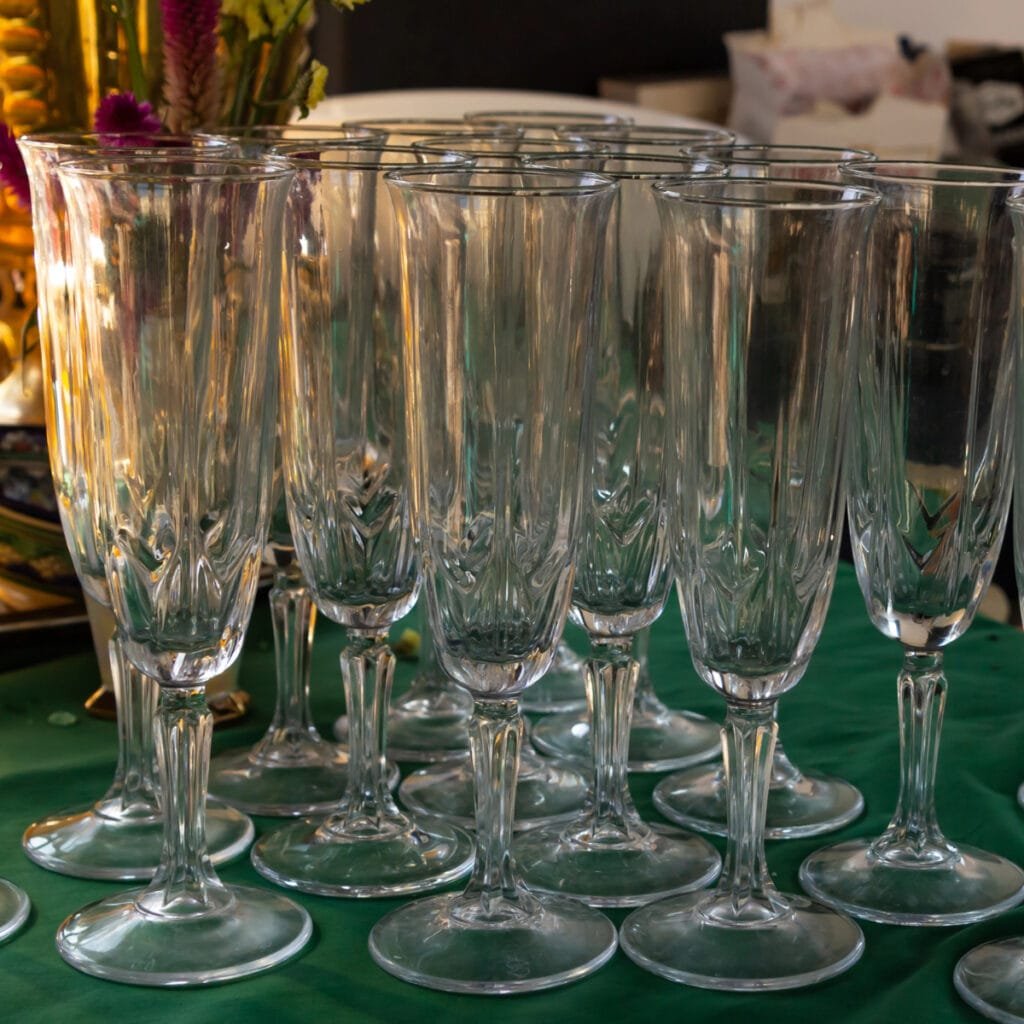
Understanding the style periods helps you narrow down when your glass was made.
Georgian Period Wine Glasses (1714-1830):
Georgian glasses are the holy grail for many collectors. They feature:
- Plain stems or intricate air twists (spirals of air trapped in the stem)
- Smaller, more delicate bowls
- Trumpet, funnel, or bell-shaped bowls
- That distinctive folded foot I mentioned earlier
The air twist stems are particularly stunning. Hold one up to the light and watch those spirals dance. Each one is unique because they were made by hand.
Victorian Period Wine Glasses (1837-1901):
Victorian glassmakers went wild with color. We’re talking peacock blue, cranberry red, emerald green, and even uranium glass that glows under UV light. The variety is incredible.
Victorian glasses also feature:
- Larger bowls for generous wine servings
- Elaborate engraving and etching
- Simpler stems (they focused on the bowl decoration)
- Rich, saturated colors that weren’t possible in earlier periods
Art Nouveau Wine Glasses (Late 1800s – Early 1900s)
Art Nouveau glassmakers were obsessed with nature and flowing movement. Think of vines, flowers, dragonflies – anything that curved and twisted organically.
You will see:
- Organic, flowing lines that mimic plants and natural forms
- Slender and curvy stems, often twisted or vine-like
- Naturalistic motifs like flowers, leaves, insects, and water themes
- Asymmetrical designs that feel balanced but not perfectly matched
- Subtle engraving and iridescent finishes (Tiffany and Loetz were masters at this)
Art Deco (1920s – 1930s)
After World War I, everything got bold and geometric. Art Deco was all about machine-age glamour, sharp angles, and that streamlined “future is now” feeling. These glasses look like they belong in a swanky cocktail lounge with jazz music playing.
Art Deco glassware mainly showcased:
- Strong geometric shapes and clean, angular lines
- Often angular, stacked stems with geometric elements
- Sharp, precise cuts and frosted panels
- Simple but stylized motifs (think sunbursts, zigzags, stepped patterns)
- Bold or jewel-toned colors
What Makes Antique Wine Glasses Valuable?
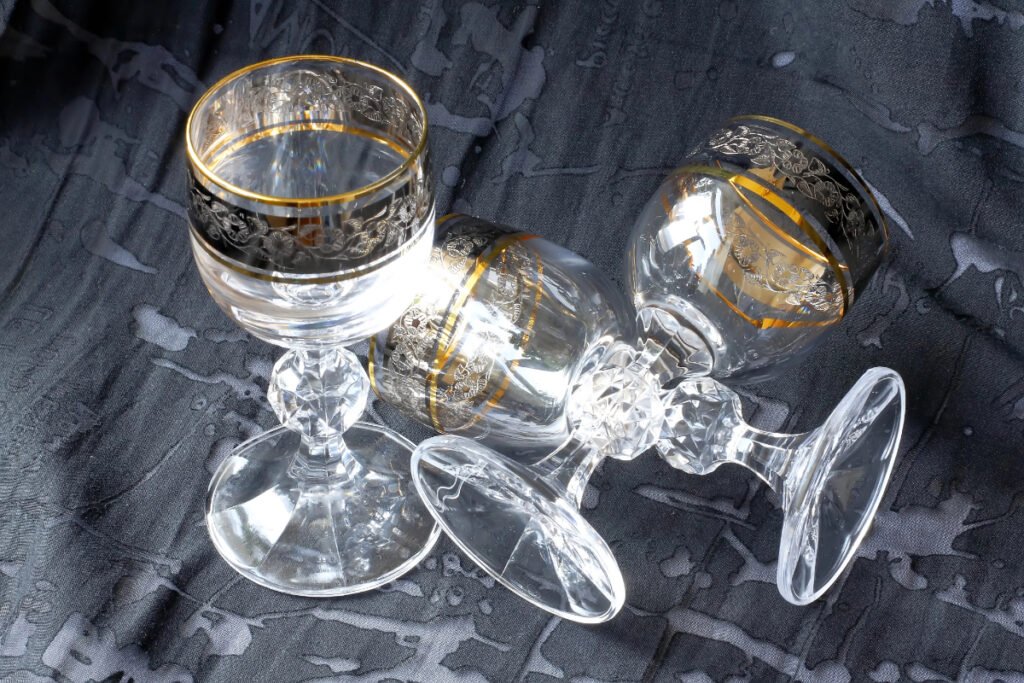
Now that you can identify vintage glasses, let’s talk about what makes some worth $20 and others worth $2,000.
Condition
In the case of vintage glassware, condition matters more than almost anything else. A common Georgian wine glass in perfect condition will often be worth more than a rare Victorian piece with chips.
Here’s something you need to watch out for:
- Rim chips: The kiss of death for value. Even tiny ones matter
- Foot damage: Very common. Many antique glasses have chipped feet from careless handling
- Stress cracks: Hard to see but devastating to value
- Clouding: Often from modern dishwashers, eating away at the surface
“Sick Glass” is something every collector dreads. Some old glass develops this permanent milky, cloudy look when moisture gets into the glass and starts a chemical reaction. It looks like internal haziness or a fine web of cracks, and there’s no fixing it.
This isn’t the same as water spots you can clean off – this is permanent damage that kills the value. Once glass gets “sick,” it stays sick.
Completeness
A complete set of matching vintage wine glasses can be worth three to five times more than the individual pieces sold separately. So, look for identical pontil marks, matching stem patterns, consistent bowl shapes and sizes, and the same color and clarity.
Also, documentation adds dollars! Meaning any paperwork, original packaging, or provenance information dramatically increases value.
Rarity Factors
Needless to say, if a wine glass or set is rare, it will be two to three times more valuable! But how can you tell if it’s rare? Well, there are certain rarity factors!
Firstly, the glass color. Certain antique wine glass colors are considered rarer than others. Here’s a quick rarity scale from most to least common:
- Extremely rare: Some experimental colors and techniques
- Common: Clear, light green, basic amber
- Uncommon: Deep blue, emerald green, purple
- Rare: Cranberry, uranium green, deep amethyst
Similarly, some design features make old wine glasses incredibly rare, such as:
- Jacobite glasses with political engravings
- Beilby enameled pieces (museum-quality)
- Unusual stem configurations
- Commemorative pieces marking historical events
Also, in general cases, the older the glass, the rarer it is. But there are exceptions. A beautifully made Victorian art wine glass piece might be worth more than a damaged Georgian glass, even though the Georgian piece is older.
12 Rare Vintage Wine Glasses to Collect Now!
Let’s check out some of the most valuable and rare antique wine glasses that have sold for $200 to $2,000 or more!
1. Tiffany Favrile Signed Goblet with Plate
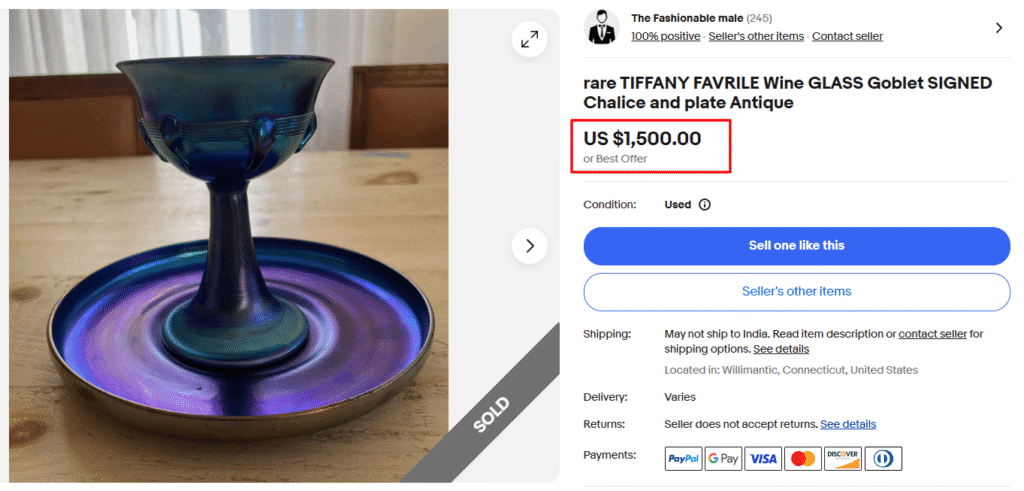
Even seen such a wine glass lately? Because these are rare! This piece is an example of Louis Comfort Tiffany’s revolutionary Favrile glass, patented in 1894! The rare blue-to-purple iridescence is created by infusing metallic oxides into the molten glass itself, making it unique.
The name “Favrile” comes from the Old English word “fabrile,” meaning hand-wrought. So, no two pieces will be identical. The matching underplate just adds more value to this already valuable glass, justifying the high price tag of $1,500 for a single piece. Imagine the price of a set!
2. Val Saint Lambert Crystal Gold Encrusted Intaglio Cut Wine Glasses
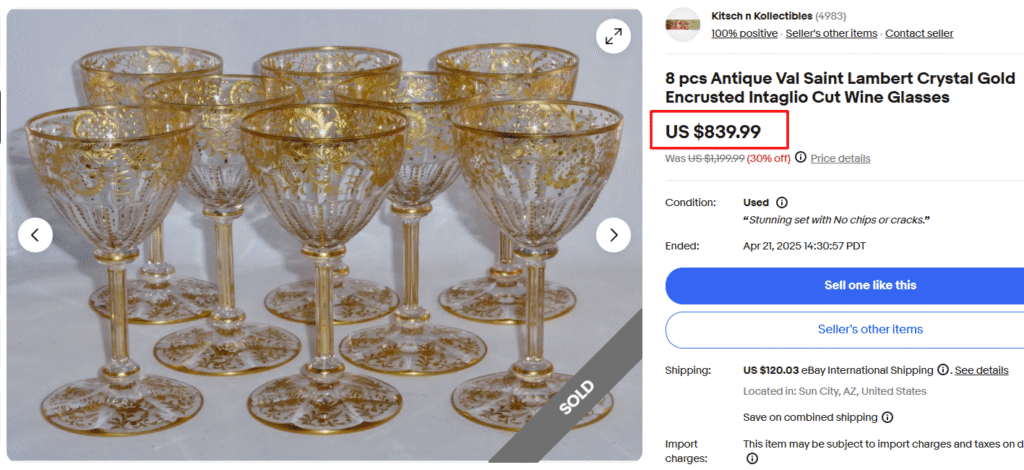
This set is easily one of the finest creations of Val Saint Lambert, founded in 1826 and holder of the royal warrant from King Albert II. Each glass features intricate intaglio cutting, where patterns are carved deep into the crystal rather than raised!
Besides, the gold encrustation involves applying real gold leaf into the cut patterns, a labor-intensive process that’s rarely seen nowadays! The elegant stems and bases with gold work make this glass a real collectible piece, with the values reaching $1,500 or more!
3. Bohemian Moser Gilt & Enameled Wine Art Glass Goblet

Just by looking at this glass, you can say it’s RARE! It’s a Moser goblet made of the rich amber-colored glass with elaborate hand-painted enamel work in gold and multiple colors, and intricate floral and scrollwork designs.
You’ll also see the bulbous stem with applied decorative elements and the gilt accents throughout, Moser’s signature luxury style. From the blown glass form to the detailed enamel painting, every element is hand-crafted, making it worth what it sold for!
4. 18th c. English Georgian Air Twist Wine Glasses
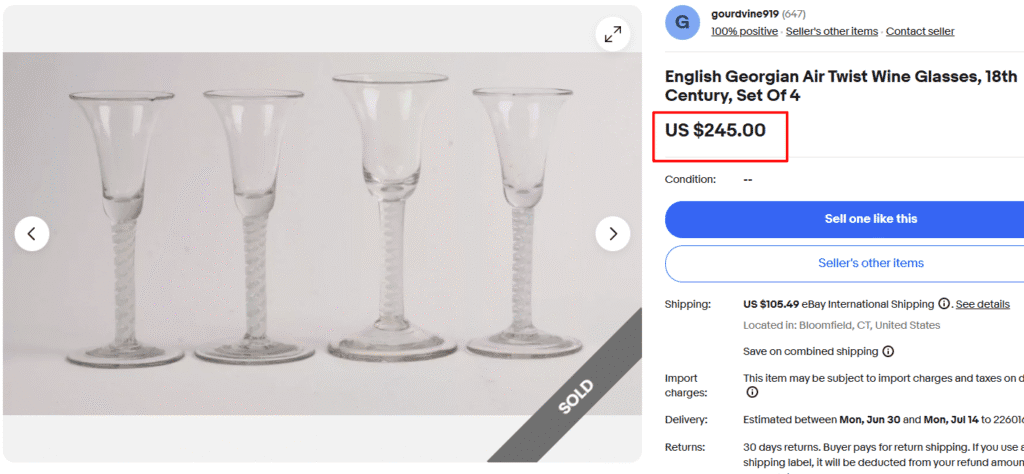
You’ll find these antique 18th-century Georgian glasses with the iconic air twist stems that made English glassware famous worldwide. The stems contain spiraling threads of air that create a mesmerizing optical effect, like capturing mercury in glass.
Made during the reign of George II around 1750, this wine glass is an absolute English rare find! The funnel-shaped bowls and conical feet follow classic Georgian proportions, while the air twist stems show the incredible technical skill of 18th-century glassblowers!
5. Signed Baccarat Green Overlay Tsar Czar Wine Goblet
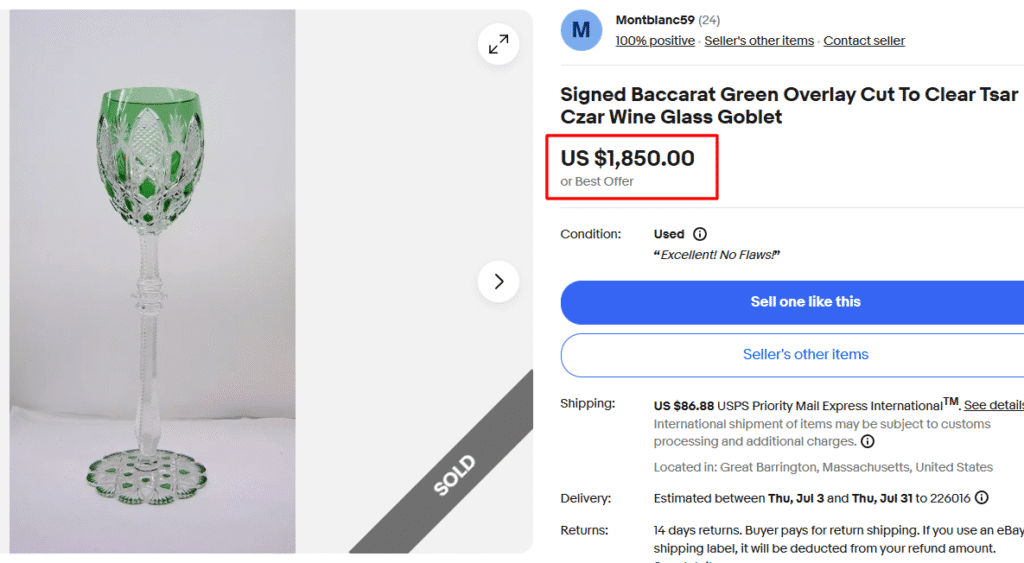
This is a museum-quality Baccarat goblet, sold for a stunning $1,850! Part of the legendary “Tsar” pattern first created for Czar Nicholas II in 1906, this glass is made of apple green overlay crystal cut to reveal brilliant clear glass in complex diamond and palm leaf patterns.
The tall, elegant form with its scalloped foot and faceted stem are the defining characteristics of Baccarat’s crystal work. Every cut is perfectly executed and polished to a mirror finish! A full set of these antique wine glasses? Probably worth over $2,500!
6. Engraved Venetian Murano Handblown Hollow Stem Wine Goblets
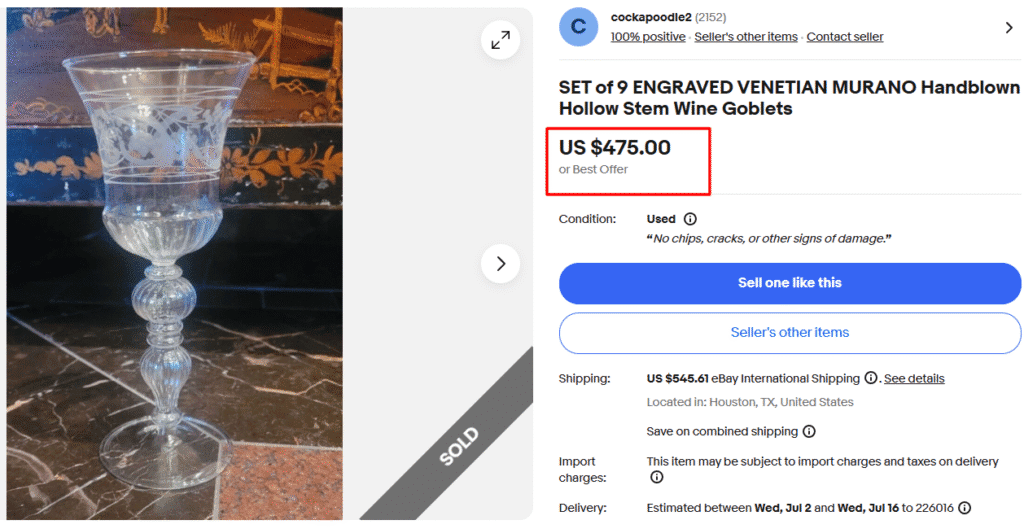
This is a rare Murano goblet with delicate hand-engraved frosted floral motifs on the bowl and an impressive hollow baluster stem with multiple decorative knops. You’ll see the clear crystal construction with hollow workmanship inside the stem – a technique that makes this glass rare!
Each glass bears slight irregularities, hand-blown bubbles, and a distinctive pontil mark on the base, the true Venetian craftsmanship.
7. Bohemian Cut-to-Clear Crystal Champagne Flute Wine Glass
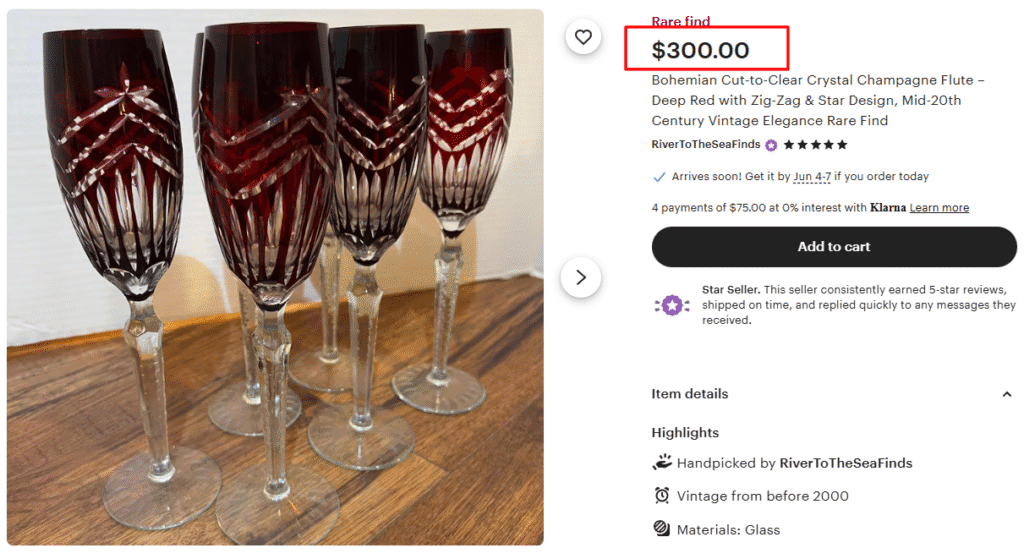
These bold champagne flutes showcase the classic Bohemian cut-to-clear technique with one of the rarest colors, deep red overlay glass in zig-zag and star patterns. The deep red casing is expertly cut away to reveal dramatic, brilliant, clear crystal underneath!
Each flute stands elegantly on a clear crystal stem, a true example of the mid-20th-century mastery of Czech glassmakers. You can expect $300-$800 for a full set of these Bohemian glasses in pristine condition!
8. 19th c. Bohemian Enameled Cut Wine Goblet
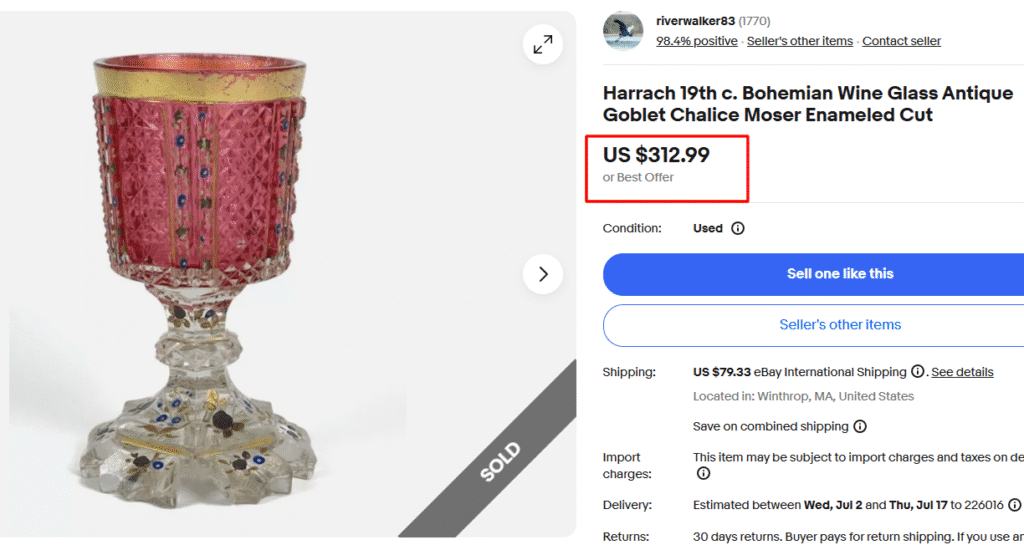
This stunning goblet shows off Harrach’s reputation as one of Europe’s finest glassmakers for over 300 years. The rare cranberry-pink colored glass with intricate diamond-cut patterns and delicate hand-painted enamel work in blues and golds is a defining characteristic.
Besides, you’ll see the complex base with applied decorative elements, the labor-intensive techniques that made Harrach pieces so valued. This piece is a true example of the Victorian era’s love for rich colors and elaborate decoration! If you find a full set, you’re lucky!
9. Moser Green to Clear Crystal Intaglio Floral Hock Wine Glass
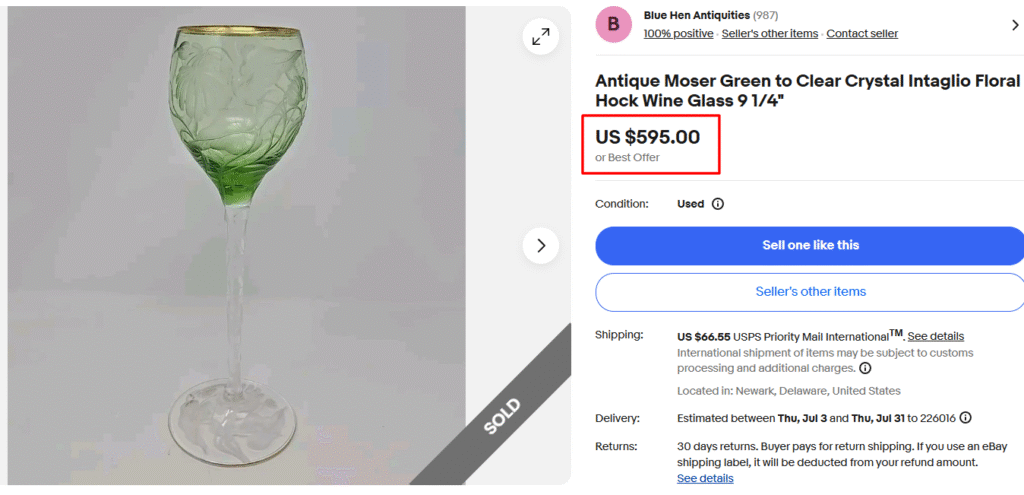
This exceptional Moser piece shows why the company became known as “the glass of kings.” The subtle apple green shaded to clear really highlights the elegant Art Nouveau intaglio cut floral decoration.
The deeply carved floral pattern is cut into the glass rather than raised, and the gilt trim accents and tall panel-cut stem make this a true collector’s piece. Moser’s mastery of color gradation from rich emerald green to crystal clear is what makes it worth the price tag of $595!
10. Murano Venetian Hand-Blown Dolphin Wine Glasses
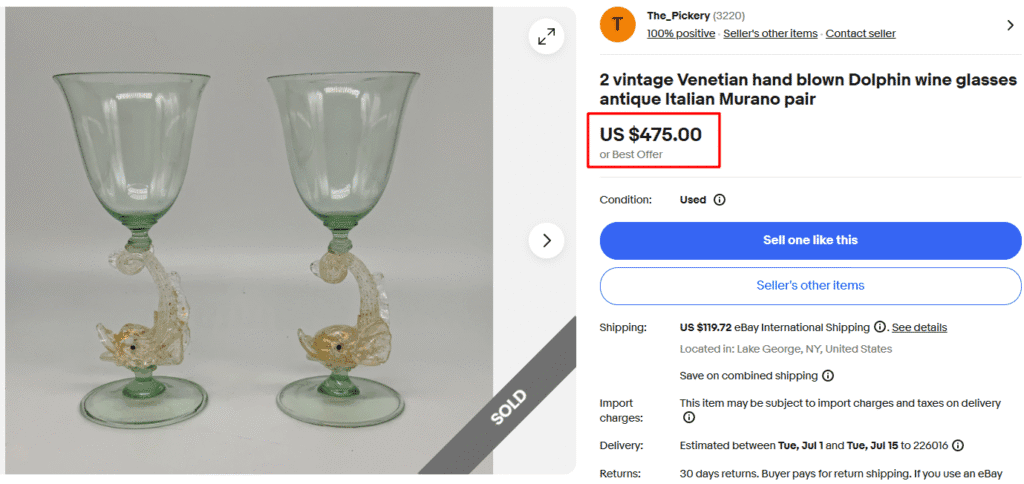
Talk about something more unique than this? These vintage Murano glass pieces feature clear glass dolphins as stems, carrying the green-tinted bowls. The eyes in each dolphin are made from a small black disc of glass worked into a larger yellow ball of glass, the classic Venetian artisans’ work!
Each piece is hand-blown Murano work, as you can see by the slight irregularities and rough pontil marks on the base. The gold flecks throughout add that signature Venetian sparkle, making these look lavish, justifying the price!
11. Bohemian Engraved Motto Scales Fruit Base Wine Glass
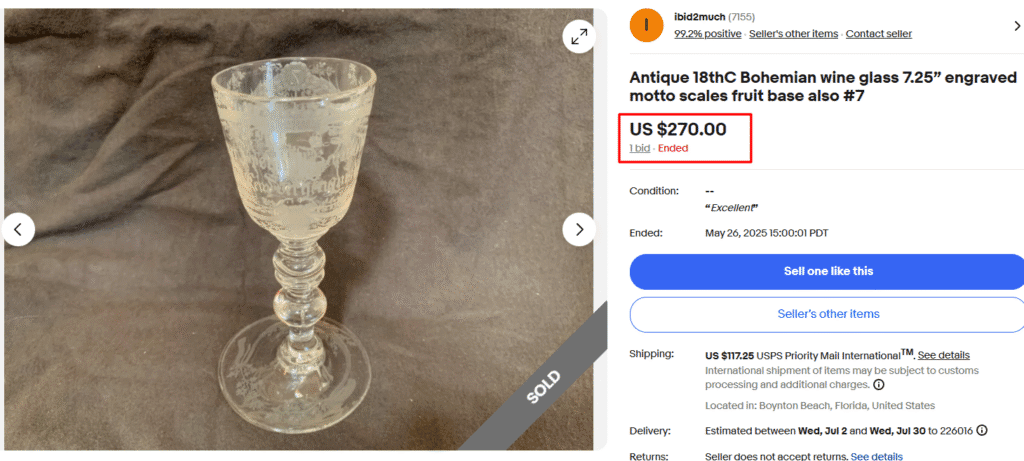
This one’s basically museum-worthy! Those hand-engraved scale patterns aren’t just pretty – they catch light and throw it around like tiny prisms. Back then, the glass engravers in places like Jablonec were doing work that English craftsmen couldn’t match until way later in the century.
That fancy baluster stem with all its little decorative bumps is the defining characteristic of this piece! If you find a full set in pristine condition, you’re probably looking at $500-$1,200!
12. German Lorraine Green-to-Clear Glass Hock Wine Gold Gilt Glass

I love how this 19th-century hock glass shifts from that gorgeous deep green to crystal clear – it’s like watching a sunset in glass form! “Hock” was just the British way of saying German white wine, and these tall beauties were made specifically for Rhine wines.
The intricate gold gilt work features delicate grape and vine motifs that are perfect for its intended purpose. The tall, slender bowl sits gracefully on a clear crystal stem, showing the Alsace-Lorraine craftsmanship! In sets, this glass can sell for $500-$1,000!
Note: This article is intended for informational, educational, and entertainment purposes only. Some images are illustrative and may not represent actual brands, products, or related entities. All trademarks, product names, brand logos, packaging, and other intellectual property referenced remain the exclusive property of their respective owners. Any brand mentions or references are provided solely for descriptive and educational context and do not imply any formal or commercial association.

